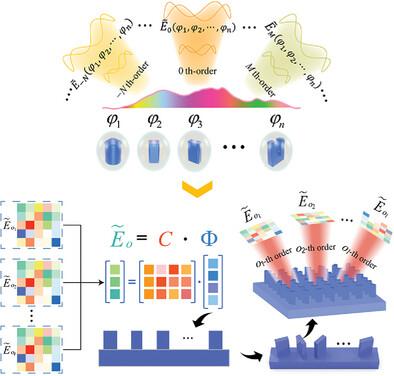在多个衍射通道上实现独立复振幅控制的异质梯度超级簇元曲面
IF 13
2区 材料科学
Q1 CHEMISTRY, MULTIDISCIPLINARY
引用次数: 0
摘要
在多个通道上实现独立复杂振幅控制的能力可显著提高光子设备的信息容量。衍射技术本身拥有众多通道,是在角空间进行密集光操控的理想选择。然而,目前还没有实现这一目标的便捷方法。在此,我们提出了一种利用硅基透射型异质梯度超小型元表面的灵活干涉方法。只需设计超级椭球内元原子辐射的相位,就能单独分析控制每个衍射通道的复振幅。最重要的是,多个衍射通道的复振幅可以非交错方式同时控制,其中通道的数量由有效调整自由度(DoF)的数量决定。作为概念验证,在太赫兹系统中实验演示了几种元设备,它们可以在不同的理想衍射角产生多个涡旋光束、焦点和分裂光束。这一进展预示着开发具有更强通道容量的多功能光子器件的新途径,为光子学的研究和实际应用提供了巨大潜力。本文章由计算机程序翻译,如有差异,请以英文原文为准。

Heterogeneous-Gradient Supercell Metasurfaces for Independent Complex Amplitude Control over Multiple Diffraction Channels
The ability to achieve independent complex amplitude control across multiple channels can significantly increase the information capacity of photonic devices. Diffraction inherently holds numerous channels, which are good candidates for dense light manipulation in angular space. However, no convenient method is currently available for attaining this. Here, a flexible interference approach utilizing silicon-based transmission-type heterogeneous-gradient supercell metasurfaces is proposed. By simply designing the phases of the meta-atoms’ radiations within a supercell, the complex amplitude of each diffraction channel can be individually and analytically controlled. Crucially, the complex amplitudes of multiple diffraction channels can be simultaneously controlled in a non-interleaved manner, where the number of channels is determined by the number of effective adjusting degrees of freedom (DoF). As a proof-of-concept validation, several meta-devices are experimentally demonstrated in the terahertz regime, which can generate multiple vortex beams, focal points, and splitting beams in different desired diffraction angles. This advancement heralds a new pathway for the development of multifunctional photonic devices with enhanced channel capacity, offering significant potential for both research and practical applications in photonics.
求助全文
通过发布文献求助,成功后即可免费获取论文全文。
去求助
来源期刊

Small
工程技术-材料科学:综合
CiteScore
17.70
自引率
3.80%
发文量
1830
审稿时长
2.1 months
期刊介绍:
Small serves as an exceptional platform for both experimental and theoretical studies in fundamental and applied interdisciplinary research at the nano- and microscale. The journal offers a compelling mix of peer-reviewed Research Articles, Reviews, Perspectives, and Comments.
With a remarkable 2022 Journal Impact Factor of 13.3 (Journal Citation Reports from Clarivate Analytics, 2023), Small remains among the top multidisciplinary journals, covering a wide range of topics at the interface of materials science, chemistry, physics, engineering, medicine, and biology.
Small's readership includes biochemists, biologists, biomedical scientists, chemists, engineers, information technologists, materials scientists, physicists, and theoreticians alike.
 求助内容:
求助内容: 应助结果提醒方式:
应助结果提醒方式:


